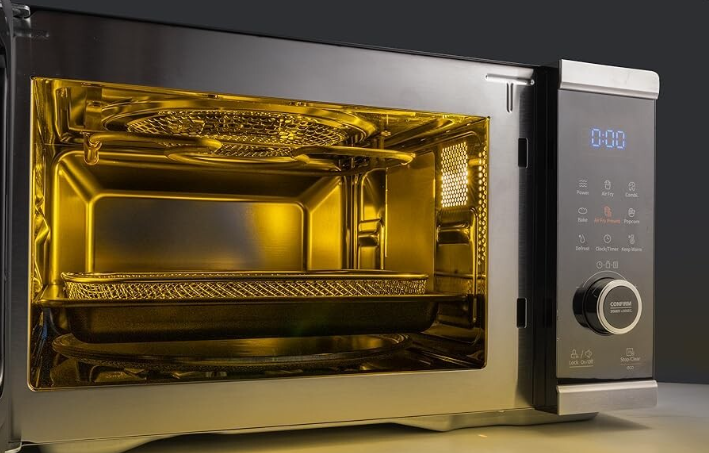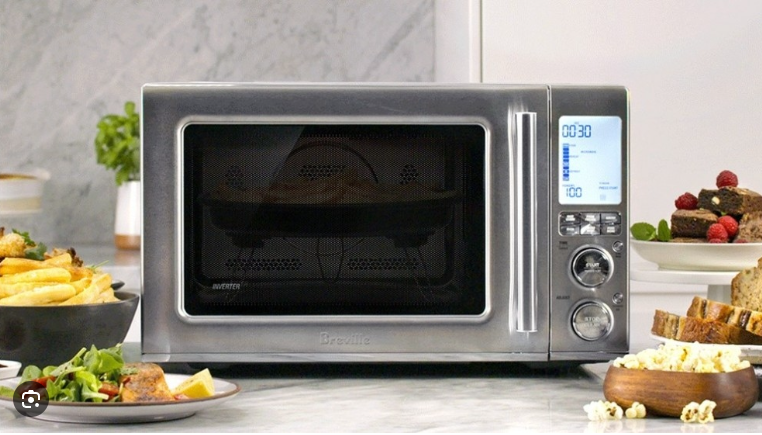Are you on the hunt for the Best Energy Efficient Microwave Oven that can zap your leftovers without zapping your wallet? In a world where every watt counts, choosing an appliance that is kind to both the planet and your electricity bill is a smart move. But with so many models boasting different features, how do you separate the truly efficient power-savers from the energy guzzlers? Don’t worry, we’re here to demystify the process. As your trusted experts in everything microwave-related, we’ll guide you through the key features, bust some common myths, and empower you to make an informed decision that you’ll be happy with for years to come.
Why Should You Care About an Energy-Efficient Microwave?
It’s a fair question. A microwave isn’t on 24/7 like a refrigerator, so how much difference can it really make? You’d be surprised. While a single microwave’s consumption seems small, it adds up. Choosing an efficient model offers two significant benefits:
- Lower Electricity Bills: An energy-efficient microwave uses less power for both cooking and standby functions. Over the appliance’s lifespan, these small savings accumulate into a noticeable reduction in your energy costs.
- Smaller Environmental Footprint: Less energy consumption means fewer carbon emissions. By opting for an eco-friendly model, you’re making a responsible choice that contributes to a healthier planet. Think of it as a small, easy step toward a greener lifestyle.
What Makes a Microwave Energy Efficient? Key Factors to Consider
Finding the best energy-efficient microwave isn’t just about picking the one with the lowest price tag. It’s about understanding the technology that powers it. Here are the crucial factors to look for when you’re shopping.
Wattage vs. Efficiency: A Common Misconception
Many people believe that a lower-wattage microwave is automatically more energy-efficient. This isn’t necessarily true. Wattage measures cooking power, not energy efficiency. A higher-wattage (e.g., 1200W) microwave cooks food faster than a lower-wattage (e.g., 700W) one. Because it runs for a shorter time, it can sometimes use the same amount of, or even less, total energy to cook the same meal. The real key to efficiency lies in how the microwave generates and delivers that power.
The Magic of Inverter Technology
If there’s one feature to prioritize in your search, it’s inverter technology. Traditional microwaves operate on an all-or-nothing principle. To cook at 50% power, they cycle the magnetron (the part that creates microwaves) on and off. This is like trying to maintain a steady speed in your car by flooring the gas pedal and then slamming on the brakes repeatedly—it’s clunky and inefficient.
Inverter technology, on the other hand, delivers a constant, steady stream of power at the level you select. This results in:
- More Even Cooking: No more dishes with hot edges and a frozen center.
- Better Defrosting: It gently thaws food without cooking the edges.
- Significant Energy Savings: By using only the necessary power, it avoids wasteful energy spikes.
“Think of inverter technology as a dimmer switch for your microwave’s power, while traditional models use a simple on/off switch. The precision of the dimmer switch not only cooks your food better but also prevents wasting electricity, making it the single most important feature for an energy-efficient appliance.”
— Dr. Kenji Tanaka, Appliance Design Engineer
Look for the Energy Star Label
The easiest way to identify an efficient model is to look for the ENERGY STAR certification. Products that earn this label are independently certified to save energy without sacrificing features or performance. An ENERGY STAR certified microwave, particularly, is optimized for low standby power consumption—the energy it uses while plugged in but not actively cooking.

An infographic showing key features of the best energy efficient microwave oven including inverter technology and an Energy Star label
Size Matters: Right-Sizing Your Microwave
Bigger isn’t always better. A large, high-capacity microwave uses more energy to heat its internal space. Consider your typical usage.
- Compact (0.5 – 0.9 cu. ft.): Perfect for dorm rooms, small apartments, or individuals who mainly reheat drinks and small meals.
- Mid-Size (1.0 – 1.5 cu. ft.): A versatile option for most families, suitable for dinner plates and larger bowls.
- Full-Size (1.6 cu. ft. and up): Ideal for large families or those who cook entire meals and use large casserole dishes in their microwave.
Choosing a size that matches your needs ensures you’re not wasting energy heating empty space.
Smart Features that Save Power
Modern microwaves come with intelligent features that can contribute to overall efficiency:
- Sensor Cooking: This function uses sensors to detect the amount of steam released by the food and automatically adjusts the cooking time and power level. It prevents overcooking and saves energy by shutting off precisely when the food is ready.
- Weight-Based Defrost: Simply enter the weight of the frozen item, and the microwave calculates the optimal defrosting time and power, preventing the energy waste associated with guesswork.
How to find the best energy efficient microwave oven for your needs
Now that you know what to look for, you can confidently compare models. Remember to balance advanced features with your actual needs. A top-of-the-line model with ten smart cooking modes is only efficient if you use them.
Here’s a simple comparison of feature sets:
| Feature | Basic Microwave | Mid-Range Efficient Microwave | High-End Efficient Microwave |
|---|---|---|---|
| Power Control | On/Off Cycling | Inverter Technology | Advanced Inverter Technology |
| Efficiency Badge | None | ENERGY STAR Certified | ENERGY STAR Certified |
| Cooking Aid | Timed Cook Only | Sensor Reheat | Multi-Stage Sensor Cooking & Defrost |
| Standby Power | High | Low | Ultra-Low |
| Best For | Occasional Use | Daily Family Use | Gourmet & High-Usage Kitchens |
Beyond the Purchase: Maintenance Tips for Peak Efficiency
Your role in energy efficiency doesn’t end after you buy the appliance. Proper care and maintenance, a topic we’re passionate about here at Microwave Oven Top, ensure your microwave runs at its best for its entire life.
- Keep It Clean: Food splatters and residue inside the microwave can absorb energy, making the appliance work harder and longer to heat your food. Wipe down the interior regularly with a damp cloth.
- Check the Door Seal: A worn-out or damaged door seal can leak microwave energy, which is both a safety concern and a major source of inefficiency. Inspect the seal for cracks or damage and ensure the door closes tightly.
- Use Microwave-Safe Cookware: Glass and ceramic are excellent choices. They allow microwaves to pass through and heat the food directly. Using non-microwave-safe containers can reflect energy and lead to longer cooking times.
- Cover Your Food: Covering your food with a microwave-safe lid or paper towel traps steam, which helps cook food more quickly and evenly, thus using less energy.

A person cleaning the interior of their energy-saving microwave oven to improve its efficiency and lifespan
“Proper maintenance is the unsung hero of appliance efficiency. A clean microwave with a tight door seal can be up to 10% more efficient than a neglected one. It’s a simple habit that pays you back on every electricity bill.”
— Maria Flores, Certified Appliance Repair Technician
Conclusion
Choosing the best energy efficient microwave oven is a savvy investment in your home and the environment. By focusing on key features like Inverter Technology and the ENERGY STAR label, selecting the right size for your needs, and practicing simple maintenance, you can enjoy perfectly cooked meals without the guilt of wasted energy. You’re now equipped with the expert knowledge to look past the marketing hype and find a reliable, cost-effective appliance that will serve your kitchen well. Go ahead and make the smart choice—your future self (and your wallet) will thank you.
Frequently Asked Questions
1. Do inverter microwaves really save energy?
Yes, absolutely. By delivering a continuous, precise stream of power instead of cycling on and off, inverter microwaves cook more efficiently and can significantly reduce your energy consumption, especially when cooking at lower power levels.
2. Is a higher wattage microwave better?
Not necessarily for efficiency, but it is for speed. A higher-wattage microwave cooks faster. The most efficient models balance high power with smart technology like inverters to use that power wisely, often resulting in less total energy used per meal.
3. How much electricity does a microwave use on standby?
It varies widely. Older models can be “energy vampires,” drawing a surprising amount of power just to keep the clock lit. An ENERGY STAR certified microwave is guaranteed to have low standby power consumption, typically under one watt.
4. Can I make my current microwave more energy efficient?
While you can’t change its core technology, you can absolutely make it run more efficiently. Following the maintenance tips above—keeping it clean, ensuring the door seal is intact, and using proper cookware—will maximize its performance and minimize energy waste.
5. What is the most important feature to look for in an energy-saving microwave?
If you have to pick just one, make it inverter technology. This feature has the most significant impact on both cooking performance and overall energy efficiency, making it the gold standard for modern, eco-friendly Microwave Ovens.